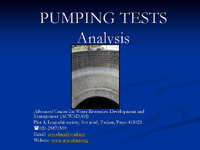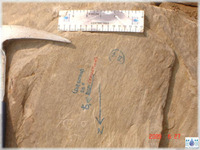Items
Tag
aquifer properties
-
 Pumping test analysis The analysis of pumping tests aims to evaluate aquifer properties, specifically Transmissivity (T) and Storativity (S), as well as well characteristics like yield. These tests involve measuring drawdown in pumping and observation wells over time and assessing recovery after pumping stops. Various methods exist for interpreting this data, with graphical techniques such as the Cooper-Jacob method being common. Specific capacity, which indicates a well's ability to yield water, is derived from pump discharge and drawdown measurements. Different approaches are used for bore and dug wells, with Slichter’s method applicable for dug wells to estimate specific capacity based on recovery data.
Pumping test analysis The analysis of pumping tests aims to evaluate aquifer properties, specifically Transmissivity (T) and Storativity (S), as well as well characteristics like yield. These tests involve measuring drawdown in pumping and observation wells over time and assessing recovery after pumping stops. Various methods exist for interpreting this data, with graphical techniques such as the Cooper-Jacob method being common. Specific capacity, which indicates a well's ability to yield water, is derived from pump discharge and drawdown measurements. Different approaches are used for bore and dug wells, with Slichter’s method applicable for dug wells to estimate specific capacity based on recovery data. -
 Permeability Thermal, electrical, and hydraulic conductivity describe a material's ability to conduct heat, electricity, and groundwater, respectively. Hydraulic conductivity determines how easily water flows through rocks, with steep slopes facilitating quicker flow compared to gentle slopes. Henry Darcy's experiments in 1856 established that the flow rate of water through porous materials is proportional to the hydraulic head difference and inversely proportional to the distance between measurement points. Darcy's law quantifies groundwater flow, emphasizing the importance of hydraulic conductivity, which varies with sediment size. Ultimately, a rock's porosity and hydraulic conductivity dictate its effectiveness as an aquifer.
Permeability Thermal, electrical, and hydraulic conductivity describe a material's ability to conduct heat, electricity, and groundwater, respectively. Hydraulic conductivity determines how easily water flows through rocks, with steep slopes facilitating quicker flow compared to gentle slopes. Henry Darcy's experiments in 1856 established that the flow rate of water through porous materials is proportional to the hydraulic head difference and inversely proportional to the distance between measurement points. Darcy's law quantifies groundwater flow, emphasizing the importance of hydraulic conductivity, which varies with sediment size. Ultimately, a rock's porosity and hydraulic conductivity dictate its effectiveness as an aquifer.